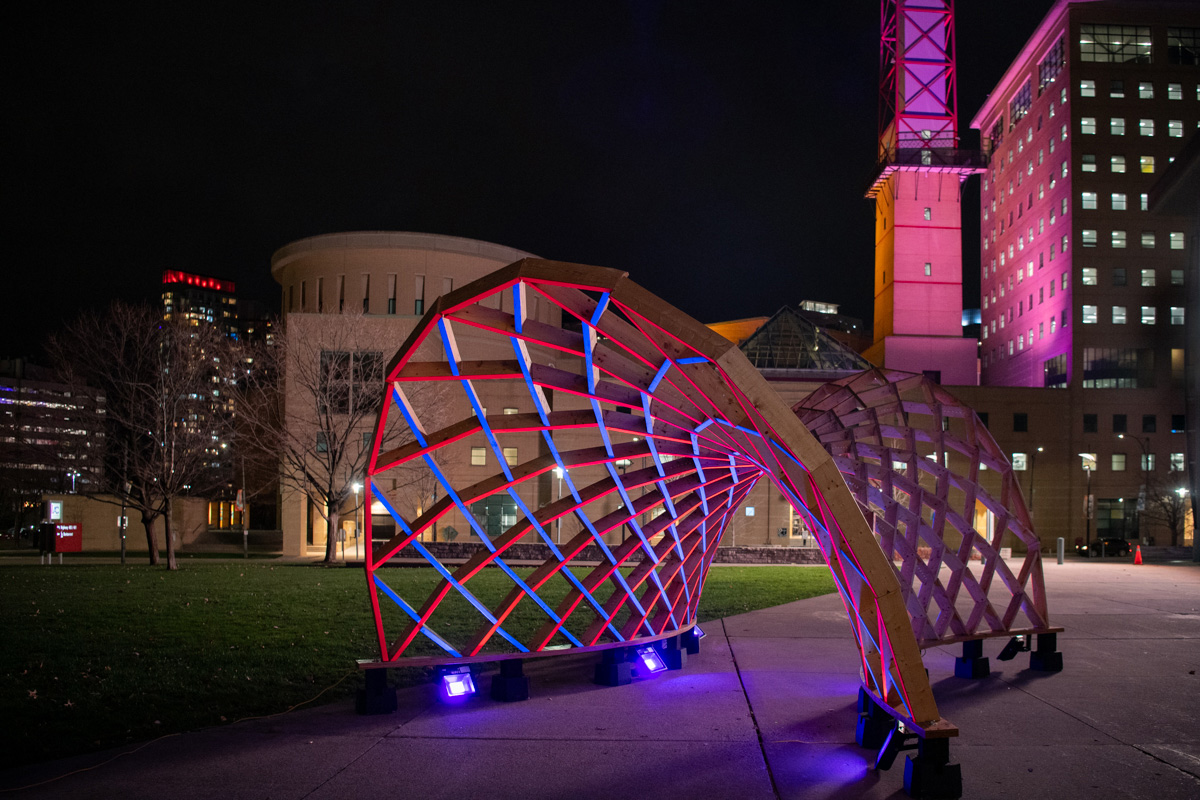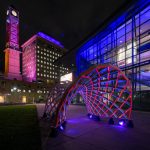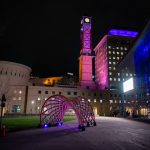Timber Tectonics
“Timber Tectonics” is currently being exhibited at Mississauga Celebration Square, as part of Winter Magic.

John Nguyen, Nicholas Hoban, Rahul Sehijpaul, Brady Peters and members from the John H. Daniels Faculty of Architecture, Landscape and Design
LED lights and Timber
2023
- John Nguyen
- Nicholas Hoban
- Rahul Sehijpaul
- Brady Peters
- John Nguyen
- Nicholas Hoban
- Shannon Hilchie – FAET Lab
- Nermine Hassanin
- Cameron Manore
- Zhenxiao Yang
- Selina Al Madanat
- Renée Powell-Hines
- Elham Khataei
- Selina Al Madanat
- Liam Cassano
- Meera Thomas
- Paul Kozak
- Zachary Mollica
About the artwork
This pavilion is the result of a research project that seeks to advance knowledge of innovative building techniques using robotic fabrication and computational design techniques.
“Timber Tectonics” demonstrates how the principle of reciprocity is applied to the creation of a reciprocal frame structure, where short wood members are interconnected to span large distances while remaining structurally sound. In a reciprocal frame structure, a minimum of three members support each other using the mechanism of resting one member on the other and/or on the ground. In addition, they support at least one other element at some intermediate point or points. If this condition is met, this elementary configuration will form a unified unit with a rightward or leftward orientation.
In a time of global supply chain issues and in an industry where efficiency and productivity are paramount, reciprocal frame structures provide the opportunity to achieve more with less. Material consumption can be reduced, accuracy can be increased, and costs can be reduced. Reciprocal frame structures facilitate faster assembly times, thereby reducing labour costs. This installation is the first robotically fabricated, doubly curved reciprocal frame structure on the American continent, and of only a handful around the world. Our research aims to create awareness and encourage more building professionals to expand on the work in this domain.
Gallery
About the artists
John Nguyen, Nicholas Hoban, Rahul Sehijpaul and Brady Peters are award-winning designers, researchers, and educators specializing in computational design, robotics, and digital fabrication at the University of Toronto. Collectively, they oversee the Acoustics Research Group, Robotics Lab and Digital Fabrication Facilities at the John H. Daniels Faculty of Architecture, Landscape, and Design. The group conducts research in the domain of timber tectonics, clay 3D printing, complex geometry, acoustics, metamaterials, and robotic fabrication.
For more, follow the team on Instagram:
More information
This artwork is being exhibited as part of Winter Magic on Celebration Square from November 25, 2023 until January 4, 2024.
Photography by Tori Lambermont.

